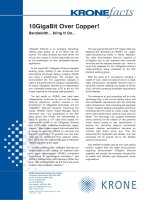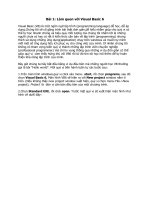Tài liệu Multi-Carrier Cellular at Louisville Baptist Hospital ppt
Bạn đang xem bản rút gọn của tài liệu. Xem và tải ngay bản đầy đủ của tài liệu tại đây (115.12 KB, 3 trang )
CASE STUDY
Multi-Carrier Cellular at Louisville Baptist Hospital
CHALLENGE
Baptist Healthcare System, Inc. is one of the largest not-for-profit
health care systems in Kentucky. Founded in 1924, Baptist Healthcare
System, Inc. (BHSI) has been bringing advanced medical technology,
modern facilities, and many of the region's most prominent physicians
and medical professionals to the cities and communities of Kentucky
for more than 70 years. The system owns five acute-care hospitals
with more than 1,500 licensed beds in Louisville, Lexington, Paducah,
Corbin and La Grange, and manages a 300-bed acute-care hospital
in Elizabethtown.
To facilitate physician and staff communications within its million square-
foot Baptist Hospital East (Baptist East) in Louisville, BHSI investigated
all of the major providers of in-building cellular systems and deployed
an InterReach Fusion
®
solution. Based on its experience, BHSI has now
standardized on solutions for its facilities statewide.
CASE STUDY
CONNECTING OUTSIDE OF THE OR
With a staff of 3,400, Baptist East offers
emergency medicine as well as specialized services
for women's health, cancer, heart, orthopedics,
neurosciences, emergency care, rehabilitation,
sleep disorders, occupational health, and
behavioral health, including psychiatric and
chemical dependency care. The 6-story structure
was built in 1974, and has been enlarged over
the years since.
In 2004, BHSI corporate IT began planning to
improve cellular coverage within the facility. “We
have a lot of anesthesiologists at our facilities, and
they were looking for a communications system
that gave them immediate contact with other
doctors and staff,” says Jim Laval, manager of
corporate IT at BHSI.
Although the doctors carried pagers, there
was always a delay of a few minutes between
sending the page and having the doctor respond
by phone. Most doctors and staff had cellular
phones from one of Louisville’s three major
carriers (AT&T, Sprint Nextel, and Verizon), but
coverage was poor inside the structure. “A lot of
the doctors had Nextel push-to-talk phones,” says
Laval, “but they only worked in the surgical areas
of the hospital. The doctors wanted something
that worked everywhere.”
Since the doctors had wanted to maintain the
push-to-talk (PTT) feature of their Sprint Nextel
phones, Laval first asked that carrier to price out
a distributed antenna system (DAS) to cover the
whole hospital. “The cost was prohibitive,” says
Laval. After Laval’s team called Verizon and found
the price to be about the same, they knew it
was time to begin looking for a multi-carrier DAS
product that BHSI could purchase outright.
MULTI-FUNCTION DAS:
DREAMS VS. REALITY
Laval and his team grew enthusiastic about
claims from some vendors about “utility-like”
DAS solutions capable of integrating all wireless
services on a single infrastructure. “We were
hoping to do a multi-function system that could
handle not only the cellular frequencies, but also
the fire and police bands, 802.11b/g, medical
telemetry frequencies at 600-618 Kilohertz, and a
future RFID system,” says Laval.
Unfortunately, vendor claims about do-it-all DAS
proved to be unfounded. “The first thing that hit
us was the cost,” says Laval. “The system was
very, very expensive. We tried to justify it with the
idea that we would put all of the services on the
one coaxial cable system, but the more research
we did, the less feasible the idea became.”
For example, Laval’s team discovered that the
wireless frequencies used for medical telemetry
equipment were governed by the FDA. The agency
requires that wireless medical telemetry traffic be
carried separately on an FDA-approved system.
The next barrier was the RFID system. “The vendor
who promised to carry RFID with cellular turned
out to have a very poor RFID solution unless you
used their own proprietary ID tags and some
additional proprietary antennas,” says Laval. “We
wanted to keep the system open so we had a
choice of vendors for these various components.”
As the BHSI technical team dug deeper, it became
obvious that the alleged features of the do-it-all
system carried a lot of compromises. At this point,
the team began re-thinking its DAS strategy. And
when the BHSI technical staff evaluated vendors
for a cellular DAS, the InterReach system stood
out. “The system was far less expensive,” says
Laval, “and it would support multiple carriers
with a far more integrated system that was
easier to install.”
FUSION BRINGS MULTI-CARRIER
FLEXIBILITY
The InterReach Fusion system supports multiple
carrier frequencies with one set of electronics
(hubs and remote antennas, or RAUs). In
addition, all wireless DAS solutions use an active
architecture that guarantees strong, uniform
signals from every remote antenna, so the quality
of service is consistent everywhere. Since Baptist
East was seeking a multi-carrier solution, BHSI
staff realized that the Fusion system’s higher
integration and use of standard CATV cabling
would make it easier to deploy.
Under Laval’s guidance,the Fusion system has
developed in Baptist East. Deployment began in
June 2006 and was completed by August. The
system covers all of the areas of the main hospital
that had poor cellular coverage, including the
emergency room, surgical suites, and patient
CASE STUDY
Website: www.adc.com
From North America, Call Toll Free: 1-800-366-3891 • Outside of North America: +1-952-938-8080
Fax: +1-952-917-3237 • For a listing of ADC’s global sales office locations, please refer to our website.
ADC Telecommunications, Inc., P.O. Box 1101, Minneapolis, Minnesota USA 55440-1101
Specifications published here are current as of the date of publication of this document. Because we are continuously
improving our products, ADC reserves the right to change specifications without prior notice. At any time, you may
verify product specifications by contacting our headquarters office in Minneapolis. ADC Telecommunications, Inc.
views its patent portfolio as an important corporate asset and vigorously enforces its patents. Products or features
contained herein may be covered by one or more U.S. or foreign patents. An Equal Opportunity Employer
105910AE 3/08 Original © 2008 ADC Telecommunications, Inc. All Rights Reserved
rooms. It includes two Main Hubs, eight Expansion
Hubs, and 64 RAUs. Carriers AT&T, Sprint Nextel,
and Verizon connected their networks to the
system by providing rooftop antennas with
cables that carried the macro network signal
down to InterReach Fusion hubs in the hospital’s
telecommunications closet.
The Fusion system supports both voice and data
services, so users can access the web, check email,
or perform other activities from anywhere in the
hospital. Since the system went live in the Fall of
2006, it has worked flawlessly. Doctors and staff
are free to use phones for any of the three major
carriers, and Baptist East supplies phones and
smart phones to some 40 top managers.
“The doctors are very enthusiastic about it,” says
Laval. “It gives them much better communications
with their offices, patients, and with each other.
They’re very happy to be able to make calls from
inside the core of the hospital.”
STANDARD CELLULAR INFRASTRUCTURE
Based on its experience at Baptist East and an
earlier deployment at Baptist Hospital Central in
Lexington, BHSI is now planning to make wireless
DAS products its standard infrastructure for
in-building cellular communications:
Baptist East is building a 250,000 square-foot, •
eight-story expansion for 2008, and the plans
include an extension of the Fusion system to
cover the new property.
BHSI is building another, 250,000 square-foot •
outpatient surgical center in Louisville in 2008,
and this will also receive a Fusion system.
BHSI is planning to deploy wireless DAS at its •
six-story Western Baptist Hospital in Paducah,
also in 2008.
With the most cost-effective and highest-
performing DAS solution in the industry, it has
made facility-wide cellular communications
a standard part of hospital infrastructure for
Baptist Healthcare System, Inc., speeding critical
communications and ensuring a happy and
productive user community.









